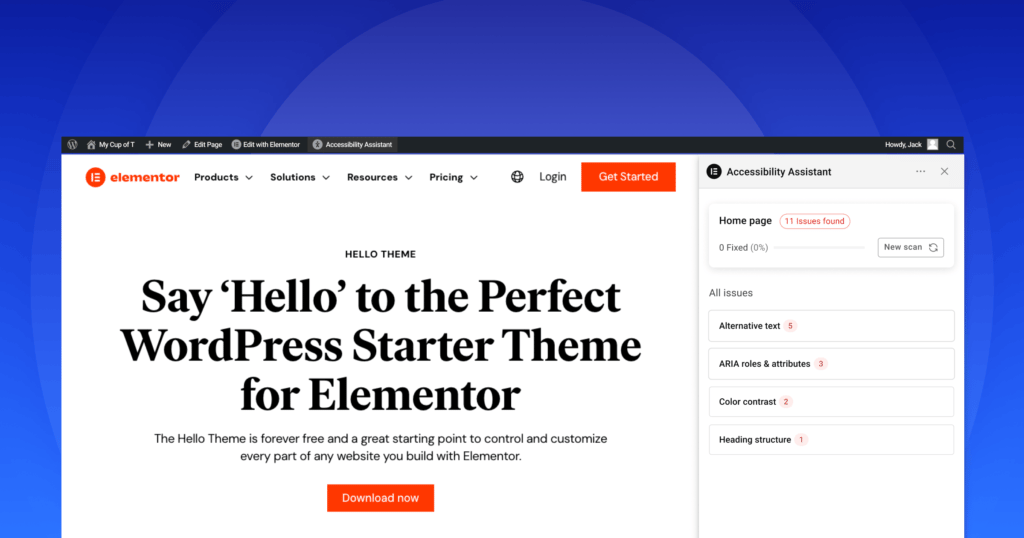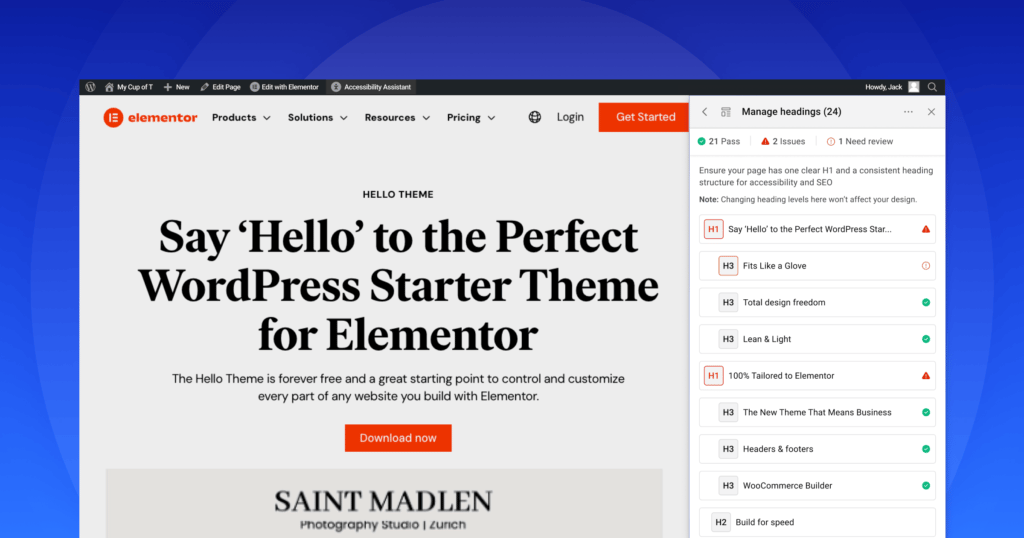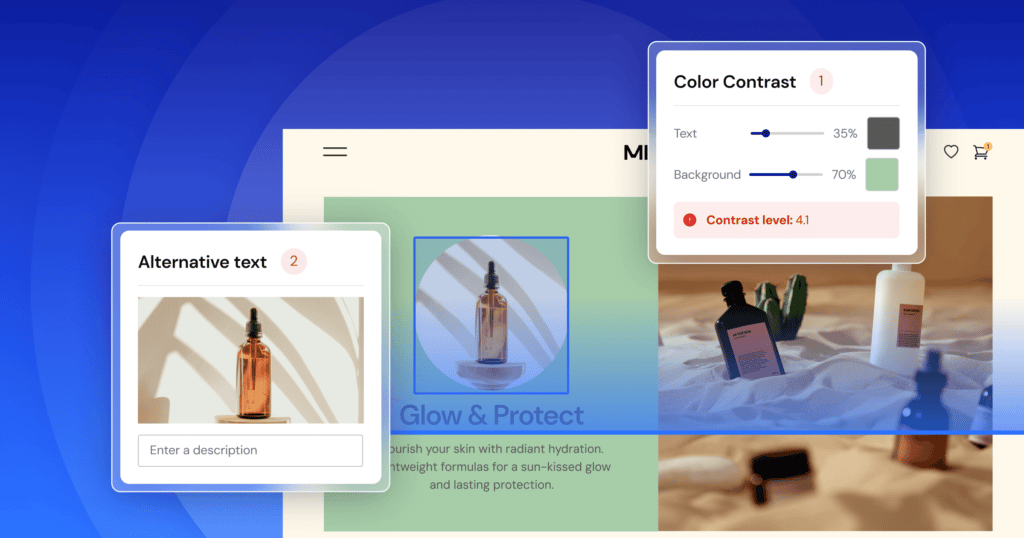Table of Contents
This release introduces three key updates:
- Heading structure remediation – discover a new way to address one of the most common accessibility and SEO issues
- Color contrast fixes – ensure readable, more accessible text across designs and devices through guided detection and remediation.
- Redesigned usability widget – improve clarity and keyboard navigation with our newly designed usability widget, recently tested by people with disabilities and refined for real-world use.
Heading structure remediation: Improve site clarity and SEO

Headings aren’t just visual elements- they’re essential for accessibility, navigation, and SEO. A clear heading structure enables screen readers to present page content in a logical order and helps search engines interpret hierarchy and relevance.
When heading levels are missing, duplicated, or skipped, people using assistive technologies can get lost, and your content may appear disorganized to search engines.
Turn accessibility into a growth opportunity with Ally
What’s new in Ally 3.8.0
With the new Headings Remediation Management, Ally now provides a guided, step-by-step flow to review and correct heading hierarchy per page- all without changing your design.
Here’s how it works

1. Detect issues
Ally now scans and identifies the three most common heading problems:
- Missing H1: Pages missing a top-level heading.
- Multiple H1s: Pages with more than one top-level heading.
Skipped heading levels: Headings out of sequence. For example, jumping from an H2 to an H6.

2. View page structure
See every heading element in a hierarchical tree view, alongside on-page indicators that visually highlight each heading. Changes appear live in both views for complete clarity.
3. Adjust or Unmark
- Unmark as heading: Keep the visual style while removing the semantic heading role (
role="presentation"). - Adjust heading level: Update hierarchy (e.g., H3 → H2). Ally automatically sets the correct ARIA level (
role="heading" aria-level="2").

4. Manage headings anytime
You can now open the “Organize Headings” view from the Assistant’s three-dots menu even if no violations are detected- perfect for reviewing clean pages or making manual adjustments.

5. Review & Apply
Confirm your changes before applying. When saved, Ally updates the ARIA heading levels to reflect the correct hierarchy while leaving your page design untouched.
Why it matters
- Improves screen reader navigation
- Strengthens SEO structure
- Keeps visual design intact (no styling changes)
If you’re asked why there’s no visible difference, it’s because the remediation updates ARIA attributes, not visual styling. What changes is how assistive technologies read and interpret the structure, not how it looks.
Turn accessibility into a growth opportunity with Ally
Color contrast fixes: Better readability for everyone
Low contrast is one of the most frequent accessibility failures, and one of the easiest to fix. Insufficient contrast makes text hard to read for users with low vision or those viewing screens in bright conditions.

The new Color Contrast Remediation in the Ally Assistant detects and helps you correct these issues instantly.
How It Works
- Ally checks text elements against WCAG 2.1 AA contrast ratios:
- 4.5:1 for regular text (below 18pt or 14pt bold)
- 3:1 for large or bold text (above 18pt or 14pt bold)
- When an issue is found, the Assistant displays:
“Text contrast of 4.1 with its background is less than the WCAG AA minimum for 14px / 400 weight text.” - You’ll see the current contrast ratio, text size, and font weight, along options to:
- Adjust text color
- Adjust background color
The “Resolve” button stays disabled until your chosen color combination meets the required contrast ratio. Once the issue is fixed, the change applies instantly so you can see the improved readability right away.
For creators who want to apply the same adjustment permanently, Ally provides the exact color values to implement in their design system or theme settings.
This means you get quick, visible results in seconds and full control over how you maintain them in your workflow.
Value to communicate:
- Enhances readability for all users
- Reduces accessibility violations quickly
- Improves design quality and user engagement
- Strengthens SEO by improving overall content legibility
A redesigned usability widget, tested by real users

Your visitors’ needs vary,and the usability widget helps them customize their experience. In this update, we completely redesigned the widget interface, following usability testing with real users with disabilities.
This redesign focused on clarity, accessibility, and ease of interaction:
- Simplified layout and control labels
- Improved keyboard and screen reader compatibility
- Optimized color contrast and focus states
- Smoother navigation across devices and assistive technologies
These refinements make it easier for visitors to adjust font size, contrast, or spacing without confusion, helping them stay longer and engage more comfortably with your content.
Turn accessibility into a growth opportunity with Ally
Coming next: Smarter accessibility management

Ally is constantly evolving to help web creators take more meaningful action toward accessibility that supports growth.
In the upcoming versions, we’re expanding your ability to manage and scale accessibility across entire websites with:
- Bulk alt text editing – review and edit multiple image descriptions in one place
- Global accessibility management – apply consistent fixes across headers, footers, menus, and sidebars
And don’t forget – the Ally Assistant already helps you:
- Detect and fix missing alt text and ARIA labels with guided, AI-powered suggestions
- Generate accessibility statements that communicate your site’s progress and intent clearly
These tools work together to make accessibility simpler, faster, and built directly into your workflow – so you can focus on creating, improving, and growing your audience.
Try the new updates in Ally Assistant
Each improvement in Ally builds on important goals: making accessibility simpler, more practical, and part of your growth strategy.
Run a new scan today to explore the latest fixes, test the redesigned widget, and see how small accessibility improvements can make a big difference in user experience and site performance.
Looking for fresh content?
By entering your email, you agree to receive Elementor emails, including marketing emails,
and agree to our Terms & Conditions and Privacy Policy.






